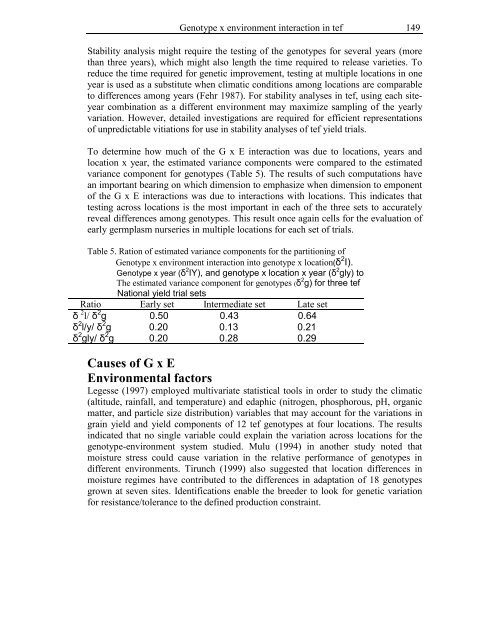Teff Reaserch and Development - Official web site of Etteff
Teff Reaserch and Development - Official web site of Etteff
Teff Reaserch and Development - Official web site of Etteff
You also want an ePaper? Increase the reach of your titles
YUMPU automatically turns print PDFs into web optimized ePapers that Google loves.
Genotype x environment interaction in tef 149<br />
Stability analysis might require the testing <strong>of</strong> the genotypes for several years (more<br />
than three years), which might also length the time required to release varieties. To<br />
reduce the time required for genetic improvement, testing at multiple locations in one<br />
year is used as a substitute when climatic conditions among locations are comparable<br />
to differences among years (Fehr 1987). For stability analyses in tef, using each <strong>site</strong>year<br />
combination as a different environment may maximize sampling <strong>of</strong> the yearly<br />
variation. However, detailed investigations are required for efficient representations<br />
<strong>of</strong> unpredictable vitiations for use in stability analyses <strong>of</strong> tef yield trials.<br />
To determine how much <strong>of</strong> the G x E interaction was due to locations, years <strong>and</strong><br />
location x year, the estimated variance components were compared to the estimated<br />
variance component for genotypes (Table 5). The results <strong>of</strong> such computations have<br />
an important bearing on which dimension to emphasize when dimension to emponent<br />
<strong>of</strong> the G x E interactions was due to interactions with locations. This indicates that<br />
testing across locations is the most important in each <strong>of</strong> the three sets to accurately<br />
reveal differences among genotypes. This result once again cells for the evaluation <strong>of</strong><br />
early germplasm nurseries in multiple locations for each set <strong>of</strong> trials.<br />
Table 5. Ration <strong>of</strong> estimated variance components for the partitioning <strong>of</strong><br />
Genotype x environment interaction into genotype x location(δ 2 I).<br />
Genotype x year (δ 2 IY), <strong>and</strong> genotype x location x year (δ 2 gly) to<br />
The estimated variance component for genotypes (δ 2 g) for three tef<br />
National yield trial sets<br />
Ratio Early set Intermediate set Late set<br />
δ 2 l/ δ 2 g 0.50 0.43 0.64<br />
δ 2 l/y/ δ 2 g 0.20 0.13 0.21<br />
δ 2 gly/ δ 2 g 0.20 0.28 0.29<br />
Causes <strong>of</strong> G x E<br />
Environmental factors<br />
Legesse (1997) employed multivariate statistical tools in order to study the climatic<br />
(altitude, rainfall, <strong>and</strong> temperature) <strong>and</strong> edaphic (nitrogen, phosphorous, pH, organic<br />
matter, <strong>and</strong> particle size distribution) variables that may account for the variations in<br />
grain yield <strong>and</strong> yield components <strong>of</strong> 12 tef genotypes at four locations. The results<br />
indicated that no single variable could explain the variation across locations for the<br />
genotype-environment system studied. Mulu (1994) in another study noted that<br />
moisture stress could cause variation in the relative performance <strong>of</strong> genotypes in<br />
different environments. Tirunch (1999) also suggested that location differences in<br />
moisture regimes have contributed to the differences in adaptation <strong>of</strong> 18 genotypes<br />
grown at seven <strong>site</strong>s. Identifications enable the breeder to look for genetic variation<br />
for resistance/tolerance to the defined production constraint.


